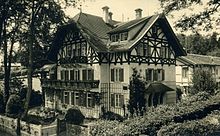Xaver Knittl
Xaver Knittl (born September 2, 1873 in Tutzing ; † March 8, 1933 there ) was a German builder . He was best known for a typical country house style on Lake Starnberg , the "Knittl style". This is characterized by its characteristic building concept, provided with an artful, ornamental decorative framework and thus completely in the spirit of late historicism .
Life
Xaver Knittl was the first of seven children of the master bricklayer Josef Knittl (previously Knittel) from Weißenbach in Tyrol and his wife Maria Greinwald, fisherman's daughter from Garatshausen . His father Josef founded the 115-year-old construction company in Tutzing in 1872, after he was appointed as a construction specialist at Lake Starnberg by Duke Ludwig in Bavaria , the owner of the small Hofmark Palace in Garatshausen and the eldest brother of Empress Elisabeth . His younger brother, Konrad Knittl, a farmer in Garatshausen, was a draftsman with him . His youngest brother Engelbert Knittl was also a master builder and in 1907 took over the construction business from Johann Biersack in Feldafing .
As a young master mason, Xaver Knittl already gained his first experience building the Kiel Canal . After graduating from the State Building School in Munich , he was allowed to hold the title of master builder and took over his father's business at the age of 21. With the title of master builder he was allowed to realize his own architectural designs himself. He decisively shaped the local regional architecture with his country houses derived from the classic farmhouse, which are characterized by elaborate ornamental frameworks and decorative fretwork or artistic wood ornaments, which only served the aesthetic enrichment. However, he also worked with well-known architects and architectural offices such as the well-known Tutzingen architect Engelbert Schnell or the Munich architects Alois Ludwig , John Herbert Rosenthal , Michael Kurz , Carl Baierle , Franz Böttge and the architectural offices Liebergesell & Lehmann and Heilmann & Littmann .
Act
In his 40-year career, he completed over 250 construction projects. In the period from 1894 to 1906 he completed 165 building projects alone. In his construction business he gave work to many people in the area: from day laborers, bricklayers to train drivers. In 1911 the company had 357 employees and was therefore the largest construction company on Lake Starnberg before the First World War . At that time it was essential for a builder to have his own gravel pit, as the building materials came from his own hand at that time. He owned his gravel pits in Tutzing and Seeshaupt . Most of the buildings were built there, but he also built country houses, villas, agricultural buildings, residential and commercial buildings, hotels, restaurants, ship and mountain huts, greenhouses and washhouses, chauffeur-driven garages, ice cellars, and much more Sewer and drainage works. His construction company took over the earthworks and masonry work for the large buildings in Tutzing: the monastery of the Missionary Benedictine Sisters (1903), the primary school and teacher's house (1915), the new town hall (1924), the Catholic St. Joseph Church (1928) and the Evangelical Christ Church (1929). Some of his buildings are listed .
Exhibitions
- Local museum Tutzing (November 12, 2015 - April 24, 2016): Knittl, Baumeister, Tutzing, houses and villas on Lake Starnberg
- Tutzing town hall: 1275 years of Tutzing (January 27, 2017 - June 16, 2017): Houses as monuments - memories and living present
literature
- Gerhard Schober: Early villas and country houses on Lake Starnberg . Oreos, Waakirchen-Schaftlach 1998, ISBN 978-3-923657-53-7 .
- Gerhard Schober: Monuments in Bavaria, district of Starnberg . Pustet, Regensburg 1991, ISBN 3-7954-1005-3 .
- How it used to be. In: Tutzinger Nachrichten , 2014, issue 1–12.
- Stefanie Knittl: Houses tell stories. The Knittl master builder family on Lake Starnberg (1872–1987). Apelles-Verlag, Starnberg 2018, ISBN 978-3-946375-05-0 .
- Community of Tutzing (ed.): Listed houses in Tutzing . Tutzing 2018, DNB 117511037X .
Web links
- TV documentary: Houses in the Knittl style: timelessly beautiful. (11 minutes) Bavarian TV, March 23, 2019, accessed on March 23, 2019.
- Radio contribution: Houses tell life stories - examples from two centuries from Lake Starnberg (24 minutes), Bayerischer Rundfunk (BR 2), Zeit für Bayern, contribution by Christine Gaupp, first broadcast on June 22, 2019
Individual evidence
- ^ Gerhard Schober: Early villas and country houses on Lake Starnberg . 1998, p. 267.
- ^ Gerhard Schober: Monuments in Bavaria, district of Starnberg . Schnell & Steiner, 1991, ISBN 3-7954-1005-3 , p. 382.
| personal data | |
|---|---|
| SURNAME | Knittl, Xaver |
| BRIEF DESCRIPTION | German builder |
| DATE OF BIRTH | September 2, 1873 |
| PLACE OF BIRTH | Tutzing |
| DATE OF DEATH | March 8, 1933 |
| Place of death | Tutzing |




